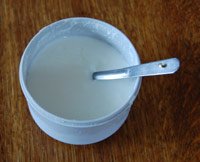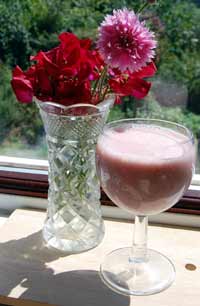Why Eat Fermented Food?
Should we eat fermented food?
Is there anything to be gained by fermenting foodstuffs now we have fresh food available 24/7 and our fridges keep food fresh for when we want it? The short answer is - Yes!
Sure, there are some fermented natural foods which people still eat a plenty. Yogurt is in that category - but most factory-produced flavoured and filled yogurts don't really cut it as "live" foods. There are some good ones of course, including probiotic yogurts, that can be worth buying from the supermarket. But for the very best fermented cultures you may need to a bit look further.
The foods I am talking about are still available but you have to seek them out. Some of the very best ones are made by small artisans and people in their own home kitchens. These are highly valuable foods with unique nutritional benefits.
Fermented food may just be the missing ingredient in your otherwise-healthy diet.

Here's a brief look at some of the commoner fermented foods and at what fermented food can do for you. This page concerns sauerkraut, yogurt cultures including acidophilus yogurt and probiotic yogurt. There is some outline information on how the living enzymes present in many fermented foods lessen the burden on the digestive enzymes which we use to process such foods.
See here to go straight to information on yogurt as well as recommended reads for sauerkraut and fermented foods.Picture above: yogurt is easy to make at home.
Some real fermented foods
- starting with sauerkraut
Most people are familiar with sauerkraut. You can probably buy some in your nearest grocery. It is a bit more than just an old-fashioned way to preserve the cabbage crop for the long cold winter in Eastern Europe. It is produced by a lactic-acid fermentation of the natural sugars in the cabbage and this process of preservation ensures that much of the vitamin C present in the fresh cabbage is preserved. The lactobacilli involved are also beneficial for your health. A few people may be intolerant of it, however.
Sauerkraut (meaning "sour cabbage" in German) is a common fermented food for many people of central and Eastern Europe. Plenty of other nations have similar fermented foods - such as Korean Kimchi. Russians have similar foods, often with added beetroot. The Dutch are fond of sauerkraut with smoked sausages and in parts of the US "kraut juice" - the liquid reserved after the fermentation - is highly valued in some areas. Sauerkraut is often eaten as a relish or side dish for meats such as bratwurst or other continental sausages.
Sauerkraut is now used worldwide but some of the mass-produced varieties may not be so great for your health. The usual problem is that companies add too much salt and/or nitrates to aid preservation, or they pasteurise the finished product - which wipes out the friendly bacteria which created the product in the first place. This turns the living food into a dead food which will certainly supply some calories as carbohydrates but not a lot else.
A safe food
If the fermentation and preservation procedure is carefully and well done, sauerkraut is a safe and healthy food.
There are three main stages in its production and it is important that they are done correctly. Home-produced sauerkraut used to be covered with a linen cloth and the top layer was inspected daily, the brine being skimmed to remove harmful moulds. Now people generally use more sophisticated and sure methods, including specialised jars and accurate temperature controls.
As a fermented health food sauerkraut has a lot to recommend it. The friendly lacto-bacilli aid digestion of the cabbage in the sauerkraut and also helps you digest other foods eaten at the same time.
There are vitamins and minerals preserved in the cabbage which would have largely escaped with other cooking methods.
Sauerkraut is an extremely safe fermented food and it will keep for weeks or months without spoiling. The only downside is that some people do have an intolerance to the amines which arise during the ferment. Amines are common in biology and are constituents of common amino acids which we all need as part of our metabolism. Amino acids are found commonly in protein foods.
Here are some recommended books on sauerkraut and natural fermented foods.Good books on making your own sauerkraut
Making Sauerkraut and Pickled Vegetables at Home: Creative Recipes for Lactic Food to Improve Your Health (Natural Health Guide) (Natural Health Guide) A carefully described guide to the practicalities of making sauerkraut and other relishes and pickles. This book will inspire confidence in the reader!
Probiotic Foods for Good Health: Yogurt, Sauerkraut All you need to know about probiotic foods at home from a noted health writer.
Yogurt - a great and ancient food
How real is my yogurt?
How to tell if a yogurt is the real deal?
Look for the words lactobacilli or Bulgarian yogurt or acidophilus on the label. Sometimes "active cultures" is somewhere on the label. Most plain yogurt still has some life in it but you can buy good quality ones in many health food shops and local farmers' markets.
A good yogurt will easily make more when stirred into warmed milk. Leave it in a warm place (a vacuum flask is most reliable) for about 24 hours and a teaspoonful of yogurt in a glass of tepid milk becomes a glass of yogurt! Ideally you need to maintain the temperature at around 100 degrees Fahrenheit.
To make good yogurt at home requires a bit more precision but you should certainly be able to tell that the milk has changed some - without going sour. (However, if you don't keep the temperature up to around 100 degrees, it will go sour!)
You can also tell whether yogurt is good quality just by eating it. It should have a pleasantly sour taste which is refreshing and not cloying. (If your yogurt tastes fizzy, it has become over active. It is best to buy or make fresh.)
If you want to make yogurt at home, it's perhaps worth buying a decent yogurt maker.

You can get a basic model from around 20 dollars or you could opt for a multi-tasking wonder such as this Automatic Frozen Yogurt, Sorbet, and Ice Cream Maker
However, you can get by very well with a wide-necked vacuum flask.For details of how to make yogurt in a flask please see: How to make yogurt
For recipes for yogurt drinks please see: Yogurt drinks to keep you cool all summer long
Picture, right: A yogurt drink made with crushed raspberries
A great food for all ages
Yogurt is a great food for all ages from infancy up. The Hunza people of northern Pakistan are famed for the high number of centenarians amongst them. They use yogurt as a big part of their diet.
Yogurt is a great food for the elderly and almost anyone who has health problems. Yogurt can be incorporated into our diets in a whole host of ways. It makes great desserts of course and yogurt drinks are absolutely delicious and very easy to make at home. You can even make bread and cakes using yogurt.
If you want to get more yogurt into your diet, try making a salad dressing with it or just add a spoonful to your salad when serving. You can also use it to accompany meat dishes, such as chili con carne.
Animals can benefit from it too. Dogs fed mainly on tinned food will benefit from a little yogurt added to their diets. Real and fermented food is important for them, too.
Sponsored links
Types of yogurt and keeping properties
The longer yogurt is kept the higher the amount of lactic acid present. Yogurt keeps very well in a fridge or cool place. Throw it out if it gets too sharp tasting. The liquid which forms on the top can be stirred back in - or used in cooking.
The thicker natural yogurts such as Greek yogurt are produced by straining the yogurt. Low fat yogurt is widespread with the current obsession with all things low fat; full fat yogurt is harder to find but is absolutely delicious at around 10% fat. If your diet is otherwise rational you do not need to fear full-fat yogurt!
Probiotic yogurts
There are new strains of yogurt coming onto the market, incorporating "probiotics" such as L. rhamnosus GR-1. This particular culture is anti-allergenic, that is it reduces people's susceptibility to allergens. A recent study at the University of Western Ontario showed that yogurt containing this particular probiotic could remain active for upto a month.
More of these new cultures are likely to become available in supermarkets and health food stores in the near future.
Yogurt will normally keep for a week or two in the fridge. Use by dates on bought yogurts tend to be conservative, for obvious reasons. Nevertheless, it is as well to be prudent about safety, especially where the elderly and the young children are in the question.
Books on yogurt
Here are a few recommended books on yogurt.
The Book Of Yogurt has had rave reviews for its fabulous recipes and ease of use. Lots of detail and fascinating insights from one of America's great food writers.
Cooking with Yogurt: The Complete Cookbook for Indulging with the World's Healthiest Food has lots of great detail on how to incorporate yogurt into many traditional recipes.
A Healthy Taste of Indian Culture - Cooking With Yoghurt (Best Health and Nutrition Book in the World) Gourmand Winner I love yogurt with Indian food. This great book gives easy to follow recipes for South Indian cuisine, using yogurt. South Indian cuisine deserves to be more widely known - it is absolutely delicious vegetarian food. Real gourmet stuff!
Sponsored links
Green Kitchen - Natural and Organic Foods
Greenfootsteps Home - for more easy green living ideas
| Tweet |

| Tweet |

Sponsored links
On other pages
Yogurt Drinks to Keep You Cool!
Footprints
- an occasional e-zine from Greenfootsteps
If you would like to receive the e-zine, please just sign up below.






New! Comments
Have your say about what you just read! Leave me a comment in the box below.